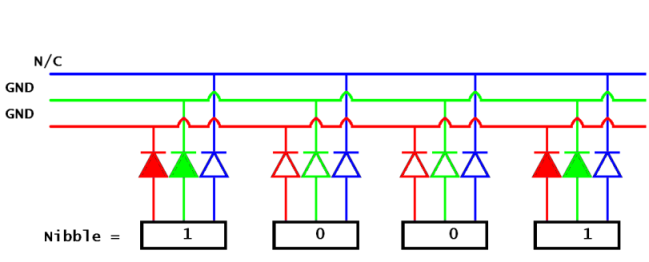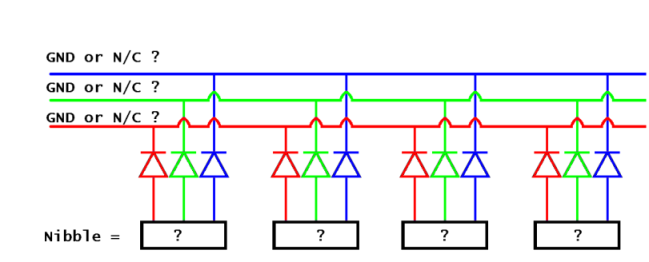| WR Home Topic Home | Chapter: 1 2 3 |
| <Previous | Next> |
Chapter 03
Circuitry for the Propeller PCB
Page 5
Some concepts about switching
Three LEDsWhat will happen if three type of LEDs Red (R), Green (G) and Blue (B) are connected together.
Same onSequence is provided to all:

Example:
CC serves as the master control.
CC_G = N/C will switch OFF all Green LEDs.

Example:
CC serves as the master control.
CC_B = N/C will switch OFF all Blue LEDs.

TDM for RGB LEDs
Reminder: Whenever the "onSequence" is NOT exactly the same for all R, G, B we will use TDM.
Without having separate anodes, the effect of having separate anodes is achieved by TDM
Example:
It is required to switch the LEDs as sown below. How will you proceed, to produce the desired "End effect" ?

Observation:
- Find the onSequence (Nibble) separately for R, G, B
- It is NOT same: Nibble_R = 1001, Nibble_G = 1111, Nibble_B = 0011
- So we need to apply TDM
| CC_R = GND, CC_G = N/C, CC_B = N/C, Nibble = 1001 (Sequence for Red LEDs) |
 |
| CC_R = N/C, CC_G = GND, CC_B = N/C, Nibble = 1111 (Sequence for Green LEDs) |
 |
| CC_R = N/C, CC_G = N/C, CC_B = GND, Nibble = 0011 (Sequence for Blue LEDs) |
 |
The slow animation shown below, illustrates the concept of TDM for RGB LEDs:

Question: If it is desired to:
switch ON all Red LEDs,
two middle Green LEDs and
none of the Blue LEDs,
What will be the TDM Cycle ?
( in other words what will be the values of CC_R, CC_G, CC_B and Nibble w.r.t. time )

.
.
.
.
.
Solution :
CC_R = GND CC_G = N/C, CC_B = N/C, Nibble = 1111
CC_R = N/C CC_G = GND, CC_B = N/C, Nibble = 0110
CC_R = N/C CC_G = N/C, CC_B = GND, Nibble = 0000
| WR Home Topic Home | Chapter: 1 2 3 |
| <Previous | Next> |